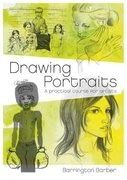
Drawing Exercises In Technique
Extract from Drawing Portraits • By Barrington Barber • Published by Arcturus PublishingAbout
Drawing Portraits
The following technical practices should help you to ease your way into drawing in a range of different styles. There are, of course, many more than the ones we show, but these will serve very well as a basis. You will discover all sorts of other methods through your own investigations and adapt them to serve your purpose.
-
 Amanda P. added Drawing Exercises In Technique to Drawing Tutorials
17 Jun 22:31
Amanda P. added Drawing Exercises In Technique to Drawing Tutorials
17 Jun 22:31
-
 Marie P. favorited Drawing Exercises In Technique
27 Apr 05:03
Marie P. favorited Drawing Exercises In Technique
27 Apr 05:03
-
 roshanitripathi favorited Drawing Exercises In Technique
21 Jan 10:57
roshanitripathi favorited Drawing Exercises In Technique
21 Jan 10:57
-
 taylor t. favorited Drawing Exercises In Technique
18 Jan 08:47
taylor t. favorited Drawing Exercises In Technique
18 Jan 08:47
-
 Crafterella featured Drawing Exercises In Technique
03 Jan 23:00
Crafterella featured Drawing Exercises In Technique
03 Jan 23:00
-
 Kinhime Dragon favorited Drawing Exercises In Technique
02 Jan 16:00
Kinhime Dragon favorited Drawing Exercises In Technique
02 Jan 16:00
-
 Arcturus Publishing published her project Drawing Exercises In Technique
02 Jan 09:00
Arcturus Publishing published her project Drawing Exercises In Technique
02 Jan 09:00
You Will Need
-
 Step 1
Step 1Pencil shading test
When you are using pencil to add tone to your drawings it soon shows if you are not very expert. The only way you can develop this facility is to practise shading in various ways in order to get used to seeing the different tones achievable. This exercise is quite difficult but good fun and can be repeated many times over a period of weeks, just to help you get your hand and eye in.
You will find the control it gives you over the pencil very valuable.
You will need a very dark pencil (4B), a slightly less dark pencil (2B) and a lighter pencil (such as a B). If you wish, you can always use a harder lighter pencil, such as an H or 2H.Draw out a long line of squares measuring about 1 in (2.5 cm) square. Shade each one, starting with a totally black square. Allow the next square of shading to be slightly lighter, and so on, gradually shading each square as uniformly as possible with a lighter and lighter touch, until you arrive at white paper
-
Step 4
3. Horizontal strokes over the strokes shown in 1 and 2.
-
 Step 7
Step 7Pencil and graphite
A pencil is the easiest and most obvious implement with which to start an exploration of technique. Try the following series of simple warming up exercises, which can be practised every day that you put aside time to draw. This is very useful for improving your technique.
1. A backward and forward motion of the hand, always in an oblique
direction, produces an even tone quickly. -
 Step 24
Step 24Shading with chalk
This next series of exercises is similar to the one you have just done but requires extra care not to smudge your marks as you put them down. The key in this respect is not to use a smooth paper. Choose one with a texture that will provide a surface to which the chalk can adhere.
1. Shading obliquely in two directions.
-
 Step 34
Step 34Brush and wash
The best way to start with brush and wash is to try these simple exercises. Your brush should be fairly full of water and colour, so mix a generous amount on a palette or saucer first, and use paper that won’t buckle.
1. With a brush full of ink or watercolour diluted in water, lay a straightforward wash as evenly as possible on watercolour paper.
-
 Step 39
Step 391. Oblique fine line
2. Vertical fine line
3. Horizontal fine line
4. Short pecks
5. Short pecks and strokes
1A. Thicker vertical lines
2A. Thicker oblique lines
3A. Draw a ball, then scrape away to reveal
lighter side
4A. Thicker, measured vertical strokes
1B. Scraped wavy lines
2B. Cross-hatching with fine lines
3B. Gradually reducing from thick to fine lines
4B. Draw an eye shape and then scrape out
light areas
1C. Lightly scraped wavy lines
2C. Thickly scraped wavy lines
3C. Criss-cross pattern
4C. Multiple cross-hatching increasing in
complexity from left to right



































